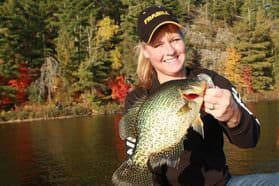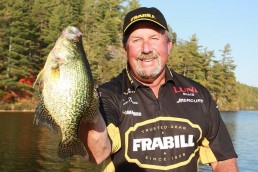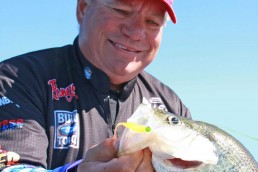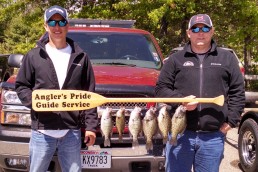Mining the Special Gold of Monster Fall Crappies
SHARE THIS POST
Truly giant crappies get me excited, and I like to put the odds in my favor as much as possible when pursuing them. For that reason, I target these special fish in the fall. And I don’t just go to any old lake; if I have a choice, I go to larger bodies of water, because they are truly the jewels that produce big slab crappies that everyone talks about and drools over. Sure, there are exceptions to the rule and there are smaller lakes that might give up an occasional 14- to 15-inch crappie, but those of us who have made a career chasing these freaks of the crappie world know that big, sprawling bodies of water are their home grounds.
Lake of the Woods, Rainy Lake, Leech Lake, Kabetogama, Upper Red Lake, Big Sandy Lake, Big Toad Lake and certain tributaries of the Mississippi River system all hold 14- to 16-inch slabs, with the potential of 17-inchers from time to time. Contacting and catching these giants is a matter of doing a good search each day. I’ll teach you how to find big schools of these fish, and stay on them.
Over the decades, we have taken numbers of these freaks of nature. Because of the vastness of these crappie-rich bodies of water, it would be almost impossible to find and catch them all; there are numbers of these monsters still available if you use the deadly combination of technology and common sense. Their gene pool is solid, and these fish receive less pressure than other size ranges due to several factors that we’ll discuss.
Finding the big ones
As with many fish species, the larger crappies don’t necessarily live right with the younger, smaller crappies. Very seldom do I catch the goliath-size crappies from the same spot that I’m catching 7- to 9-inchers. The larger crappies are somewhat nomadic, and even though they can be taken in good numbers when located, they are very special and care should be taken to release most of them after a quick photo.
Compare the sizes of what’s considered a trophy among other species and 15- to 16-inch crappies are right up there with 30-inch walleyes, 20-inch bass, 10- to 11-inch sunfish, 40-inch northern pike, and 50-inch muskies.
When I’m searching for monster crappies in the fall, I’m looking for schools of suspended fish. I usually detect these large schools first with either side-imaging or down-imaging sonar, and then I’ll look at the fish using my underwater camera. I want to see that they’re crappies, and what sizes I’m dealing with.
If they are the size I’m pursuing, I get into fish-catching mode and it’s game on.
There is a difference in underwater cameras, and I love my Aqua-Vu because it has a color display that gives me a clear picture even when the water is slightly turbid. (The model number is AV 760-cz.) By carefully studying big schools of crappies with the camera, you’ll notice that many times, smaller (7- to 9-inch) fish tend to be in the top half of the school. The monster crappies tend to be in the middle or lowest portion of the school.
Knowing this affects my choice of baits, and how much those baits weigh.
Pinpoint presentations
In these instances, most often I’ll drop a #3 Jigging Rap through the school at a fast pace, trying to bypass the smaller crappies to get down to the big boys (or girls). Choosing a relatively heavy jig can accomplish the same thing. There are specific times when a very subtle approach must be used, and toning down size to maybe a 1/16-ounce bait might be the ticket. But I usually start with a heavier bait and try to punch it down through the smaller fish, stopping it slightly above the depth the big fish are holding in.
Crappies can be extremely finicky at times, so experiment with size, weight, and even color as you try to trigger bites. If the crappies are lying in the mud or tight to a hard bottom, then employing a “dragging along the bottom” system will be effective. Longline trolling at speeds of .2 to .3 mph with 1/16- to 1/8-ounce jigs is another method that has produced well for me.
Are you enjoying this post?
You can be among the first to get the latest info on where to go, what to use and how to use it!
You need to have enough line out to accomplish the dragging technique without imparting too much jigging action. I prefer a slightly longer rod, such as a 7-foot light action model with 4-pound-test mono or “6-2” Sufix 832 braid (with no-stretch superlines, those numbers indicate the breaking strength of the line, 6 pounds in this case, and the equivalent diameter when compared to monofilament line, same as 2-pound mono in this case).
When you get a bite while dragging the jig, let the rod tip “load up” (bend), then firmly set the hook. This can be an amazing presentation when these goliath crappies are gorging themselves on bloodworms. I seldom catch smaller crappies with this presentation.

There is a cliché that says, “there are rods for all seasons and rods for all the right reasons.” Fishing big crappies is not about using pool-cue-type rods, but one that has a soft tip and good feel. For overall use, I prefer a light to medium-light action rod 6 feet, 6 inches long. That rod will telegraph the lightest of bites, but still have enough backbone to handle the biggest slabs you will encounter. Many times the bite of monster crappies will just load up the tip of the rod, and if the rod tip gives with the bite, you can allow the fish to hang on long enough for you to react and set the hook before the fish spits the bait out. Among my rod collection, I choose a Daiwa DXW, at 6 feet, 6 inches, because it has all the qualities I just described: it’s quick, light, fast and strong. Works perfectly when I’m after these fall monster crappies.
Narrowing the search
Fall crappies can be mysterious at times, but with good populations present, bays connected to larger open-water basins will contain countless schools. Find some schools and you can set up a “milk run” of spots. I mark the schools as waypoints on my GPS, so I can easily get back into the area. The school might have moved, but switching over to watching my sonar display lets me locate the fish again.
For active crappies that nearly always bite, look for schools with fish 3 to 12 feet off the bottom, with slight separation. Usually this occurs when the day starts to warm and the bloodworms begin to rise off the bottom. That tells you the smorgasbord is set and the fish are likely to be in the mood to eat.
But what about early in the morning, when the fish might be laying tight to the mud bottom? Good question, and I have a solution that I’ve developed over the years. When I start my search for these big fall crappies, I look for soft-bottom bays near basins, as I described. When the fish are tight to bottom it’s difficult to see them, but I have figured out how to do it using the features of my Humminbird Onyx unit. With a three-fisted approach using side imaging, down imaging and color sonar, I can make short work of finding and sitting on schools pretty efficiently. The side imaging feature lets me comb large areas looking for transitional bottom differences. Differing bottom types show up differently, and white dots on the display reveal the presence of crappies. Many times, I will see clusters of dots that depict a school of crappies, and then I will go back over the school with the unit set in traditional sonar mode, and “gold is found.” It’s exciting when you feel confident you’re presenting baits to these big fish.
Another method I love is using “spot loc” on my MinnKota Ulterra bow-mount trolling motor. With the touch of a finger, the motor keeps me right on top of schools of crappies. It automatically adjusts to wind, keeping me on the spot. A common practice in the fall, where patience is needed, you can observe the masses of bloodworms slowly rise from the bottom with schools of crappies in hot pursuit. Depths of 25 to 40 feet are usually my target depths throughout the late fall and into early ice. If you don’t have these depths available on the crappie waters you fish, then many times 15 to 20 feet is a key zone.
Except for rare occasions on shallow lakes, where you might find a good weedline bite in the fall, this is mainly a deep-water game. (For example, some of the prairie lakes in southern and western Minnesota don’t always have deeper mud basins, but are teeming with weedline crappies.)
Fall is a special time of the year, and there are so many opportunities to be outdoors. It’s my favorite time of the year to observe Mother Nature as she orchestrates the movement of fish and wildlife. If you are looking for goliath crappies, the table is set. Use the tools above, do your homework, and you can mine this special gold.
Book a day on the water with Tom Neustrom at mnfishingconnections.com.
MWO
SHARE THIS POST
Did you enjoy this post?
You can be among the first to get the latest info on where to go, what to use and how to use it!



